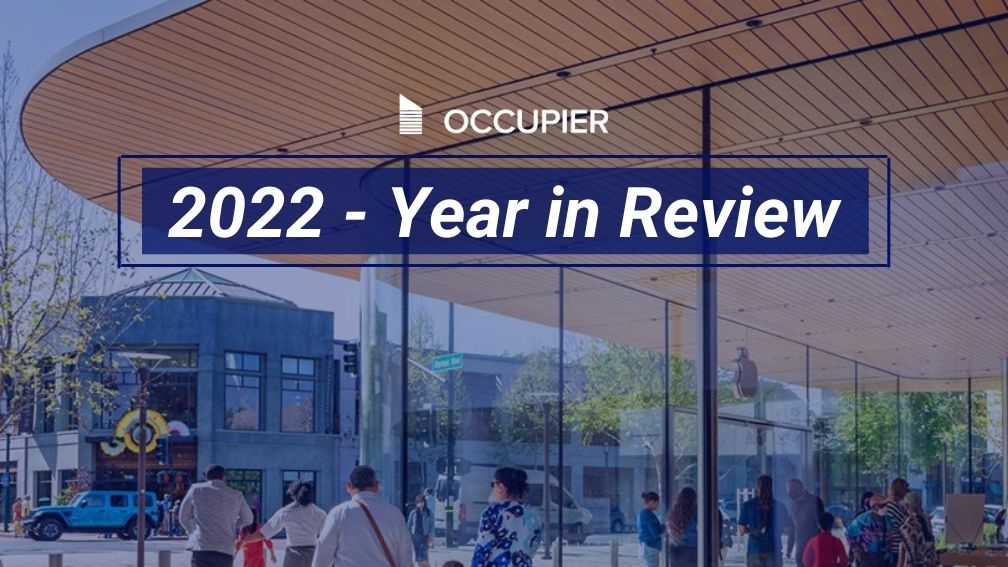Occupier – 2022 Year in Review
Last Updated on February 9, 2023 by Morgan Beard
Two themes embody our 2022 year in review from the commercial real estate lens: retail resurrection and office optimism.
After two years of uncertainty and lockdown, consumers have re-emerged, looking forward to community engagement, great customer experiences, and convenience in their daily lives.
And, commercial tenants are building spaces that meet the needs of their customers, whether they are shoppers or employees. Recent data and trends highlight these updated consumer behaviors and indicate a shift in people’s relationship with commercial space.
Watch our 2022 – Year in Review
🛍️ Retail resurrection – Brands open brick and mortar
Two years ago, retailers and restaurateurs alike shuttered their doors. Today, the demand for in-person experiences is hot. Within the Occupier platform, we have seen our retail tenants scale their footprint +6.86% in the second half, with an average of 130 leases. According to Google Search, queries for “restaurants open now,” skyrocketed by 600% in 2022. Consumers are ready to get back to in-person experiences in the places they love most, eateries and retailers.
Our tenant users aren’t the only one’s seeing growth. Retail vacancies across the states hit a 15-year low with less than 6% in vacancies. In addition, the retail sector set a new record for Black Friday weekend sales topping $9 Billion with Adobe predicting holiday sales will hit + 2.5% YoY growth.
On the flip side, inflation, economic uncertainty and rising construction costs + rent escalations are increasing commercial operating costs for retailers. With such high demand for space, rents are increasing and commercial tenants are asking themselves if now is the right time to sign a new lease… or if they should wait.
Watch our webinar – Knowing when to sign a retail lease…
🏢 Office optimism – Corporate occupiers re-evaluate office space
Office occupancy rebounded to its highest level since pre-pandemic at 48%. The traditional office is continuing to evolve. Momentum is shifting away from large corporate headquarters with snacks, happy hours, and ping pong. And, instead, office occupiers are adopting a more community oriented office strategy with smaller spaces, conveniently located closer to employees everyday. On the Occupier platform, our office tenants saw a +6.03% increase in their office lease portfolio with an average of 42 leases.
The quantitative and qualitative data sets show that corporate tenants are ditching large spaces in favor of smaller, remote office spaces that better accommodate their employees. Thus allowing their office staff to live and work within their community and without a long commute.
To learn more about the direction of corporate office space, check out our Co-Founders main takeaways from CoreNet 2022.
Check out our CoreNet 2022 Office Takeaways
🏥 Healthcare meets hospitality – Preventative wellness space is on the rise
Healthcare real estate has received a post-pandemic face lift. New primary care organizations are adopting a preventative approach that meets patients in their community. With that comes, this concept of Medtail or Healthtail which is driving healthcare expansion into traditional retail space. All as a means to meet patients in their local communities in order to provide affordable and accessible healthcare.
A recent report from Grandview Research showed that the U.S. retail clinics market size was valued at about $1.4 billion in 2016. By 2025, it’s projected to grow exponentially at a CAGR of 20 percent. The pandemic accelerated the adoption of MedTail and specialized care as a whole.
Early this year we sat down with Chris Wadley, Managing Director & Regional Healthcare Lead Broker with JLL Houston to discuss this trend.
Watch our webinar – The Evolving Landscape of Healthcare Real Estate
🔮 2023 Predictions & Beyond
With a tightening of the capital markets, organizations of all sizes and across all verticals are looking to conserve cash flow. There are three largest cost centers for most organizations, they are: payroll, real estate, and operating expenses.
Between inflation, economic uncertainty, and navigating consumer sentiment, 2023 is going to test commercial tenants’ resilience and ability to balance cutting costs while achieving growth goals. After slimming budgets, the next logical step is to review your commercial lease portfolio for saving opportunities as well as potential risks.
Here at Occupier, we empower commercial tenants to manage their entire lease portfolio from site selection to critical date management and lease accounting compliance. Better real estate decision making starts by consolidating your lease data into a single source of truth. So that your broker, real estate, construction, facilities, finance, and accounting teams can collaborate in an automated solution.
Real estate is central to your organization’s strategic goals for 2023.
